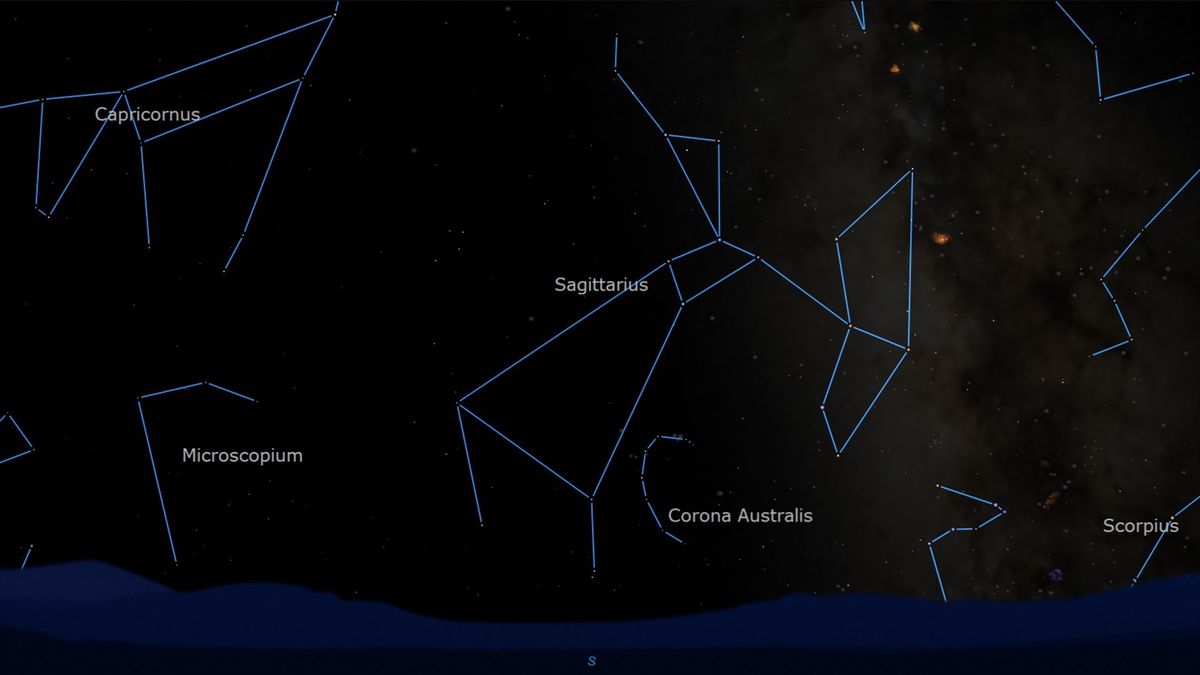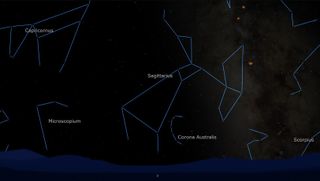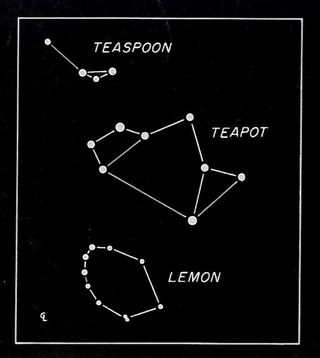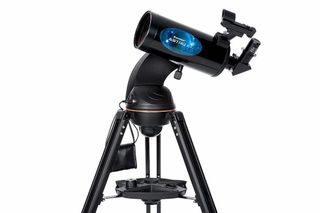
While some constellations demand our attention by the brilliance of their stars alone (Orion being the most noteworthy example), others are attractive because of their patterns of more modest stars.
Often the pattern is quite unrelated to the official name of the constellation. Most of us find it quite impossible to put ourselves in the frame of mind of whatever ancient stargazer placed a centaur, or even a standing archer for the stars of Sagittarius. In his classic constellation guide, "The Stars — A New Way to See Them," the late Hans Augusto ("H.A.") Rey, did find a way to turn the stars of Sagittarius into a standing archer.
Nevertheless, whenever I'm giving a star talk either outdoors or under the pretend universe of a planetarium dome, I take delight in pointing out that constellation's Teapot, a device not familiar in antiquity.
Now prominent in September skies, and crossing the meridian as night falls, is the asterism that most modern stargazers recognize as the "Teapot in Sagittarius," which, quite possibly, is the most perfect of all the sky pictures we have.
Just think: we happen to reside at just the right spot in our galaxy at just the right moment in time to witness a group of eight bright stars forming an excellent depiction of an object that is very familiar to us all.

To the best of my knowledge, the person who most popularized the Teapot pattern was Henry Neely, who lectured at New York's Hayden Planetarium during the 1940's and '50's and who The New York Times referred to as "the dean of New York stargazers." One of Neely's acolytes, George Lovi, who designed the monthly star charts for Sky & Telescope magazine, later pointed out that some neighboring stars relative to the Teapot could also portray other requisites for a tea service.


Looking for a telescope for the next night sky event? We recommend the Celestron Astro Fi 102 as the top pick in our best beginner's telescope guide.
From several faint stars, poised above the Teapot's lid, Lovi formed the Teaspoon, ready to be used. And below the Teapot is a charming circlet of nine stars ranging from fourth to fifth magnitude, which was one of the 48 original constellations cataloged by Ptolemy in the second century AD: Corona Australis, the Southern Crown; a star pattern of considerable antiquity. It is said to represent a crown of laurel or olive leaves.
Get the Space.com Newsletter
Breaking space news, the latest updates on rocket launches, skywatching events and more!
While it's small enough to be squeezed into the bowl of the Big Dipper, its distinctive pattern attracts attention as soon as one has a good look at that part of the sky.
And Mr. Lovi turned it into a Lemon!
Incidentally, if any of you prefer milk with your tea, you can readily convert the handle of the Teapot into a bowl, and the top of the pot (along with an adjacent star) into a bent handle, at one time, popularly known as the "Milk Dipper," which presumably can be used, to dip up the Milky Way.
Ostriches and Centaurs
Sagittarius is one of the 12 constellations of the zodiac. Not knowing much about teapots, the ancient Arabs thought of the triangle that forms the spout as a group of ostriches on their way to drink from the Milky Way, and the quadrilateral of stars that formed the handle as ostriches returning from their refreshment.
Sagittarius is generally thought to be a centaur — half man and half horse — and is usually considered to be Chiron, who is also identified with the constellation of Centaurus the Centaur. However, Sagittarius is seen as holding a drawn bow, which is not in character with Chiron, who was known for his wisdom and kindness. Some say that Chiron created the constellation to guide Jason and the Argonauts as they sailed on the great ship Argo.
Starry wonderland
This region in many ways might be the most remarkable in all the heavens. It is a veritable starry wonderland whether viewed with the unaided eye, with binoculars, through telescopes, or on photographs taken by great observatories.
Here in the direction of the central region of our galaxy is the great Sagittarius star cloud, brightest and grandest of all the regions which form the framework of our home galaxy. Here the band of the Milky Way is at its broadest, although cut by dark bands of interstellar dust. It is a treasure trove of galactic and globular clusters, plus bright and dark nebulas.
Want to see the stars of Sagittarius or anything else in the night sky up close? Be sure to check out guides for the best binoculars and the best telescopes. And if you're interested in taking your own impressive skywatching images, we have recommendations for the best cameras for astrophotography and the best lenses for astrophotography.
Joe Rao serves as an instructor and guest lecturer at New York's Hayden Planetarium. He writes about astronomy for Natural History magazine, the Farmers' Almanac and other publications.
Join our Space Forums to keep talking space on the latest missions, night sky and more! And if you have a news tip, correction or comment, let us know at: community@space.com.

Joe Rao is Space.com's skywatching columnist, as well as a veteran meteorologist and eclipse chaser who also serves as an instructor and guest lecturer at New York's Hayden Planetarium. He writes about astronomy for Natural History magazine, Sky & Telescope and other publications. Joe is an 8-time Emmy-nominated meteorologist who served the Putnam Valley region of New York for over 21 years. You can find him on Twitter and YouTube tracking lunar and solar eclipses, meteor showers and more. To find out Joe's latest project, visit him on Twitter.








